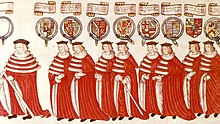
The Lord Mayor of London is the mayor of the City of London, England, and the leader of the City of London Corporation. Within the City, the Lord Mayor is accorded precedence over all individuals except the sovereign and retains various traditional powers, rights, and privileges, including the title and style The Right Honourable Lord Mayor of London.
Peerages in the United Kingdom form a legal system comprising both hereditary and lifetime titles, composed of various ranks, and within the framework of the Constitution of the United Kingdom form a constituent part of the legislative process and the British honours system. The British monarch is considered the fount of honour and is notionally the only person who can grant peerages, though there are many conventions about how this power is used, especially at the request of the British government. The term peerage can be used both collectively to refer to the entire body of titled nobility, and individually to refer to a specific title. British peerage title holders are termed peers of the Realm.

The Most Noble Order of the Garter is an order of chivalry founded by Edward III of England in 1348. The most senior order of knighthood in the British honours system, it is decoration outranked in precedence only by the Victoria Cross and the George Cross. The Order of the Garter is dedicated to the image and arms of Saint George, England's patron saint.

Court dress comprises the style of clothes and other attire prescribed for members of courts of law. Depending on the country and jurisdiction's traditions, members of the court may wear formal robes, gowns, collars, or wigs. Within a certain country and court setting, there may be many times when the full formal dress is not used. Examples in the UK include many courts and tribunals including the Supreme Court of the United Kingdom, and sometimes trials involving children.

The University of Oxford has a long tradition of academic dress, which continues to the present day.
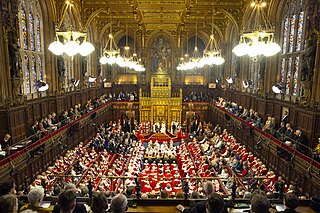
The State Opening of Parliament is a ceremonial event which formally marks the beginning of each session of the Parliament of the United Kingdom. At its core is His Majesty's "gracious speech from the throne", which is read by the monarch but written by HM Government. In the speech the monarch gives notice of forthcoming state visits, before setting out the government's legislative programme for the new parliamentary session. No business of either House of Parliament can proceed until the Sovereign’s speech has been delivered.
The introduction is a ceremony in the House of Lords of the United Kingdom by which a new member is "introduced" to the existing membership. Introductions in the Lords are more elaborate than those in the House of Commons.
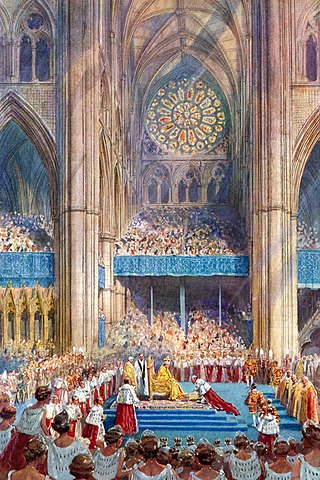
The coronation of the monarch of the United Kingdom is an initiation ceremony in which they are formally invested with regalia and crowned at Westminster Abbey. It corresponds to the coronations that formerly took place in other European monarchies, which have all abandoned coronations in favour of inauguration or enthronement ceremonies. A coronation is a symbolic formality and does not signify the official beginning of the monarch's reign; de jure and de facto their reign commences from the moment of the preceding monarch's death or abdication, maintaining legal continuity of the monarchy.

The cope is a liturgical vestment, more precisely a long mantle or cloak, open in front and fastened at the breast with a band or clasp. It may be of any liturgical colour.

In British heraldry, a coronet is any crown whose bearer is less than sovereign or royal in rank, irrespective of the crown's appearance. In other languages, this distinction is not made, and usually the same word for crown is used irrespective of rank In this use, the English coronet is a purely technical term for all heraldic images of crowns not used by a sovereign, and implies nothing about the actual shape of the crown depicted. A Coronet is another type of crown, but is reserved for the lower ranks of nobility like Marquesses and Marchionesses, Earls and Countesses, Barons and Baronesses, and some Lords and Ladys. The specific design and attributes of the crown or coronet signifies the hierarchy and ranking of its owner.
The privilege of peerage is the body of special privileges belonging to members of the British peerage. It is distinct from parliamentary privilege, which applies only to those peers serving in the House of Lords and the members of the House of Commons, while Parliament is in session and forty days before and after a parliamentary session.

Typical of British heraldry, a cap of maintenance, known in heraldic language as a chapeau gules turned up ermine, is a ceremonial cap of crimson velvet lined with ermine, which is worn or carried by certain persons as a sign of nobility or special honour. It is worn with the high part to the fore, and the tapering tail behind. It may substitute for the torse in the heraldic achievement of a person of special honour granted the privilege by the monarch. It thus appears in such cases on top of the helm and below the crest. It does not, however, feature in the present royal coat of arms of the United Kingdom, which shows the royal crest upon the royal crown, itself upon the royal helmet.
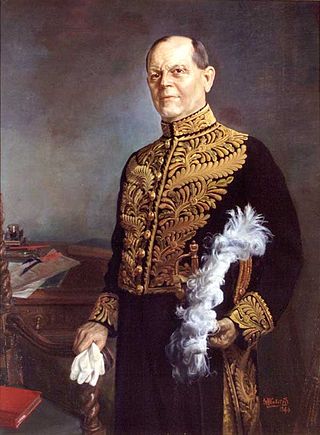
Court uniform and dress were required to be worn by those in attendance at the royal court in the 19th and early 20th centuries.
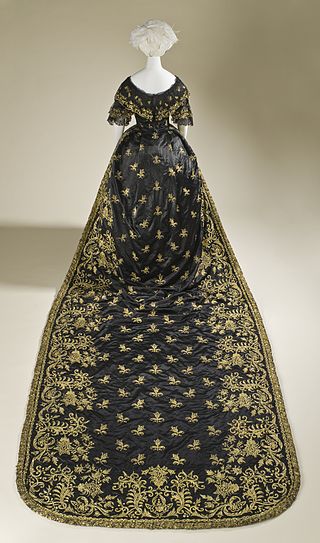
In clothing, a train describes the long back portion of a robe, coat, cloak, skirt, overskirt, or dress that trails behind the wearer.

Academic dress prescribed at the Trinity College Dublin follows a relatively complex protocol which, nonetheless, shares some particular characteristics with other universities in Ireland and with the University of Oxford in the United Kingdom.

Several Swedish coronation robes from the 16th to the 19th century are preserved at The Royal Armoury in Stockholm, Sweden. The youngest one, Oscar II's coronation robe from 1873, is in the Treasury at Stockholm Palace.
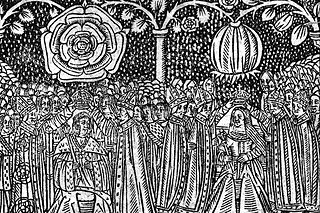
The coronation of Henry VIII and his wife Catherine as King and Queen of England took place at Westminster Abbey, London, on 24 June 1509. Henry ascended the throne two months prior, following the death of King Henry VII on 21 April, and Catherine became his wife and queen on 11 June. The ceremony was presided over by William Warham, the incumbent Archbishop of Canterbury, and organized by Lady Margaret Beaufort, the King's grandmother.

The coronation of James I and his wife Anne as King and Queen of England and Ireland was held on 25 July 1603 at Westminster Abbey. James had reigned as King James VI of Scotland since 1567. Anne was anointed and consecrated with prayers alluding to Esther, the Wise Virgins, and other Biblical heroines. It was the first coronation to be conducted in English instead of Latin. A planned ceremonial Royal Entry to London was deferred until 15 March 1604.

The coronation of Mary I as Queen of England and Ireland took place at Westminster Abbey, London, on Sunday 1 October 1553. This was the first coronation of a queen regnant in England, a female ruler in her own right. The ceremony was therefore transformed. Ritual and costume were interlinked. Contemporary records insist the proceedings were performed "according to the precedents", but mostly these were provisions made previously for queens consort.

The Robe of State is a robe worn by the British monarch on state occasions. A monarch typically has a robe made for their coronation and reuses it when attending the State Opening of Parliament at the start of each legislative session. Traditionally the robes have an ermine cape with a long train made of crimson coloured velvet, trimmed in gold lace and lined with ermine.

